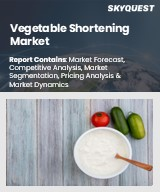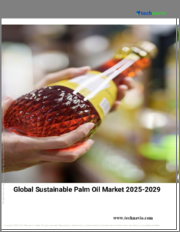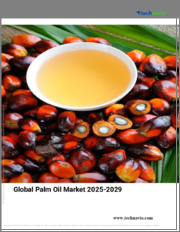
|
시장보고서
상품코드
1642806
팜유 시장 보고서 : 용도별, 지역별(2025-2033년)Palm Oil Market Report by Application (Household Cooking, Food & Beverages, Oleo Chemicals, Personal Care, Animal Feed, Bio-fuel), and Region 2025-2033 |
||||||
세계의 팜유 시장 규모는 2024년 572억 달러에 달했습니다. IMARC Group은 2025년부터 2033년까지의 성장률(CAGR)은 3.42%로 전망되며, 2033년에는 775억 달러에 달할 것으로 예측했습니다. 범용성 향상과 폭넓은 제품 용도, 급속한 인구 증가, 현저한 경제 개척, 신흥국 시장의 중간층 확대, 팜유 생산 비용 대비 효과, 건강상의 이점에 대한 의식 증가 등이 시장 성장을 뒷받침하는 주요 요인입니다.
팜유은 매우 효율적인 작물이며, 단위 면적당 상당한 양의 오일을 생산하기 때문에 많은 산업에서 선호됩니다. 상온에서는 반고체이기 때문에 식용유, 마가린, 구운 과자 등 다양한 식품 용도에 최적입니다. 요리의 영역을 넘어, 야자유는 또한 화장품, 세제, 바이오 디젤 등 엄청난 유형의 비식품에 사용됩니다.
화장품 및 바이오연료와 같은 식품 및 비식품 산업에서 야자유의 다용도로 인해 야자유는 세계적으로 요구되는 제품이 되고 있습니다. 또한 세계 인구가 증가하고 있기 때문에 가공식품과 식용유 등 팜유를 포함한 식품에 대한 수요가 높아지고 있습니다. 이 외에도 경제국가가 발전함에 따라 팜유를 함유하는 간편 식품에 대한 수요가 높아지고, 산업 용도로의 사용도 증가하고 있습니다. 이 밖에 아시아를 중심으로 하는 신흥 시장에서의 중간층 확대가 가공식품과 퍼스널케어 제품의 소비 확대를 촉진하여 팜유 수요를 더욱 밀어 올리고 있습니다. 이에 따라 팜유 생산은 다른 오일 씨앗에 비해 단위 면적당 생산량이 많기 때문에 비용 효율적이며 생산자에게 매력적입니다. 게다가 환경문제와 온실가스 배출 감축의 필요성으로 인해 바이오디젤 및 기타 재생가능 에너지원으로 팜유의 이용이 확대되고 있습니다. 또한 일부 지역에서는 건강 지향 소비자와 규제 기관이 포화지방을 포함한 팜유에 대한 감시의 눈이 엄격해지고 시장 수요에 영향을 줄 수 있습니다.
팜유 시장 경향 및 촉진요인 :
제품 다양성 및 광범위한 용도
팜유는 식용유와 마가린에서 구운 과자와 스낵 과자에 이르기까지 수많은 식품의 주요 원료가 되고 있습니다. 상온에서 반고형의 성질은 많은 가공 식품의 식감과 보존성을 높입니다. 게다가, 야자유는 안정된 성질을 가지고 있기 때문에 산화하기 어렵고 튀김에 적합합니다. 식품업계 이외의 팜유는 화장품, 비누, 세제 등의 퍼스널케어 및 가정용 제품의 제조에 중요한 역할을 합니다. 팜유은 이러한 제품에 촉촉함과 끈적거림을 줄 수 있는 능력으로 평가됩니다. 또한 팜유는 바이오연료 산업에서의 사용도 늘어나고 있으며, 신재생 에너지원으로서 수요 증가에 공헌하고 있습니다. 다양한 분야에 적응할 수 있는 팜유는 항상 높은 시장 수요를 가진 상품입니다.
급속한 인구 증가
중간 소득층이 증가함에 따라, 그들의 식생활의 선호도는 가공 식품과 간편 식품으로 바뀌어 팜유이 자주 사용됩니다. 이 인구동태의 변화는 특히 소득수준이 상승하고 있는 신흥국에서 팜유시장의 성장에 직접적인 영향을 미치고 있습니다.
현저한 경제개발
각국이 발전하고 도시화함에 따라 팜유를 포함한 편의점과 가공품에 대한 의존도가 높아지고 있습니다. 팜유에 대한 수요는 신흥 경제 국가에서 윤활유 및 바이오 디젤과 같은 산업 용도로 확산되고 있습니다. 게다가 경제 성장에 따라 가처분소득이 증가하여 소비자가 팜유를 사용한 폭넓은 제품을 구입할 수 있게 되는 경우가 많습니다. 이러한 경제개발 효과는 팜유가 농촌의 고용과 경제활동의 중요한 원동력이 되고 있는 동남아시아와 같은 지역에서 특히 두드러집니다.
목차
제1장 서문
제2장 조사 범위 및 조사 방법
- 조사의 목적
- 이해관계자
- 데이터 소스
- 1차 정보
- 2차 정보
- 시장 추정
- 상향식 접근
- 하향식 접근
- 조사 방법
제3장 주요 요약
제4장 서문
- 개요
- 주요 업계 동향
제5장 세계의 팜유 산업
- 시장 개요
- 시장 실적
- 생산량 동향
- 소비량의 동향
- 시장 내역 : 유형별
- 시장 예측
제6장 세계의 팜유 산업
- 시장 개요
- 시장 실적
- 수량 동향
- 금액 동향
- COVID-19의 영향
- 가격 분석
- 주요 가격 지표
- 가격구조
- 가격 동향
- 시장 내역 : 지역별
- 시장 내역 : 용도별
- 시장 예측
- SWOT 분석
- 개요
- 강점
- 약점
- 기회
- 위협
- 밸류체인 분석
- 원재료 공급자
- 프로세서
- 리셀러
- 수출업체
- 소매업체
- 최종 소비자
- Porter's Five Forces 분석
- 개요
- 구매자의 협상력
- 공급기업의 협상력
- 경쟁도
- 신규 참가업체의 위협
- 대체품의 위협
- 시장 성장 촉진요인 및 성공 요인
제7장 주요 지역의 실적
- 인도
- 시장 동향
- 시장 예측
- 인도네시아
- 시장 동향
- 시장 예측
- 중국
- 시장 동향
- 시장 예측
- 유럽연합
- 시장 동향
- 시장 예측
- 말레이시아
- 시장 동향
- 시장 예측
- 기타
- 시장 동향
- 시장 예측
제8장 시장 내역 : 용도별
- 가정요리
- 시장 동향
- 시장 예측
- 식품 및 음료
- 시장 동향
- 시장 예측
- 오레오케미컬즈
- 시장 동향
- 시장 예측
- 퍼스널케어
- 시장 동향
- 시장 예측
- 동물사료
- 시장 동향
- 시장 예측
- 바이오연료
- 시장 동향
- 시장 예측
제9장 경쟁 구도
- 시장 구조
- 주요 기업
제10장 팜유의 제조 공정
- 제품 개요
- 상세한 프로세스 흐름
- 다양한 유형의 단위 조작
- 매스 밸런스 및 원재료 요건
제11장 프로젝트의 상세, 필요조건 및 비용
- 토지 요건 및 비용
- 건설 요건 및 비용
- 공장의 기계
- 주요 기계의 사진
- 원재료 요건 및 지출
- 원재료 및 최종 제품의 사진
- 포장 요건 및 지출
- 운송 요건 및 지출
- 유틸리티 요건 및 지출
- 인원 요건 및 지출
- 기타 설비투자
제12장 대출 및 자금 지원
제13장 프로젝트의 경제성
- 프로젝트의 자본 비용
- 기술 경제적 파라미터
- 공급망의 각 단계에서의 제품 가격 및 마진
- 과세 및 감가상각
- 수입 예측
- 지출 예측
- 재무 분석
- 이익 분석
제14장 주요 기업 프로파일
- Archer-Daniels-Midland Company
- Asian Agri
- Boustead Holdings Berhad
- IJM Corporation Berhad
- IOI Corporation Berhad
- Kuala Lumpur Kepong Berhad
- Kulim Malaysia Berhad(Johor Corporation)
- PT Dharma Satya Nusantara Tbk
- PT PP LONDON SUMATRA INDONESIA TBK
- PT Sampoerna Agro Tbk
- PT. Bakrie Sumatera Plantations tbk
- Sime Darby Plantation Berhad
- United Plantations Berhad
- Univanich Palm Oil Public Company Ltd.
- Wilmar International Ltd.
The global palm oil market size reached USD 57.2 Billion in 2024. Looking forward, IMARC Group expects the market to reach USD 77.5 Billion by 2033, exhibiting a growth rate (CAGR) of 3.42% during 2025-2033. The rising versatility and wide product application, rapid population growth, significant economic development, expanding middle class in emerging markets, cost effectiveness of palm oil production, and increasing awareness about its health benefits are some of the major factors propelling the market growth.
Palm oil is a highly efficient crop, producing a significant yield of oil per unit of land, making it a preferred choice for many industries. It is semi-solid at room temperature, making it ideal for various food applications, such as cooking oil, margarine, and baked goods. Beyond the culinary realm, palm oil is also found in a vast array of non-food products, including cosmetics, detergents, and biodiesel.
The versatility of palm oil in both food and non-food industries, such as cosmetics and biofuels, makes it a sought-after commodity worldwide. Additionally, the increasing population across the world creates a rising demand for food products, including those containing palm oil, such as processed foods and cooking oils. Other than this, as economies develop, there is a greater demand for convenience foods, which often contain palm oil, as well as increased usage in industrial applications. Besides this, the expanding middle class in emerging markets, particularly in Asia, is driving greater consumption of processed foods and personal care products, further boosting palm oil demand. In line with this, palm oil production is cost-effective, as it yields a higher quantity of oil per unit of land compared to other oilseeds, making it attractive to producers. Furthermore, the use of palm oil in biodiesel and other renewable energy sources has grown, driven by environmental concerns and the need to reduce greenhouse gas emissions. Moreover, health-conscious consumers and regulatory bodies in some regions have led to increased scrutiny of palm oil due to its saturated fat content, potentially affecting market demand.
Palm Oil Market Trends/Drivers:
Versatility and Wide Application of the Product
It is a key ingredient in numerous food products, ranging from cooking oils and margarine to baked goods and snacks. Its semi-solid nature at room temperature enhances the texture and shelf life of many processed foods. Moreover, palm oil's stable properties make it a preferred choice for frying due to its resistance to oxidation. Beyond the food industry, palm oil plays a vital role in the production of personal care and household products, including cosmetics, soaps, and detergents. It is valued for its ability to provide moisture and consistency to these products. Additionally, palm oil is increasingly used in the biofuel industry, contributing to its growing demand as a renewable energy source. Its adaptability across various sectors makes palm oil a commodity with a consistently high market demand.
Rapid Population Growth
As more people enter the middle class, their dietary preferences evolve toward processed and convenience foods, which frequently contain palm oil. This demographic shift has a direct impact on the growth of the palm oil market, particularly in emerging economies where income levels are rising.
Significant Economic Development
As countries develop and urbanize, there is a greater reliance on convenience foods and processed products that contain palm oil. The demand for palm oil also extends to industrial applications, such as lubricants and biodiesel, in developing economies. Additionally, economic growth often leads to greater disposable income, enabling consumers to afford a wider range of products that incorporate palm oil. This economic development effect is especially pronounced in regions like Southeast Asia, where palm oil is a significant driver of rural employment and economic activity.
Palm Oil Industry Segmentation:
Breakup by Application:
Household Cooking
Food & Beverages
Oleo Chemicals
Personal Care
Animal Feed
Bio-fuel
Household cooking dominates the market
The ubiquity of palm oil in household kitchens across the globe is a primary driver. It is a staple cooking oil in many cultures due to its affordability, neutral flavor, and versatility. Palm oil's semi-solid state at room temperature makes it ideal for frying, sauteing, and baking, enhancing the taste and texture of a wide array of dishes. Its widespread availability and affordability further cement its place as a preferred choice for cooking purposes in households. Additionally, the sheer size of the global population necessitates a substantial volume of cooking oil. As more people gain access to kitchens and start cooking at home, the demand for cooking oils like palm oil naturally rises. The world's growing middle class, particularly in emerging markets, contributes significantly to this trend as they increasingly opt for home-cooked meals.
Breakup by Region:
India
Indonesia
China
European Union
Malaysia
Others
Indonesia exhibits a clear dominance in the market
The market research report has also provided a comprehensive analysis of all the major regional markets, which include India, Indonesia, China, European Union, Malaysia, and others. According to the report, Indonesia accounted for the largest market share.
Indonesia is also the largest producer of palm oil in the world. The tropical climate of the country and vast expanses of suitable land makes it exceptionally conducive to palm oil cultivation. The favorable growing conditions, combined with the availability of a skilled labor force, enable Indonesia to produce a substantial quantity of palm oil, which in turn, influences its dominance in the market. Additionally, the Indonesian government has actively supported the palm oil industry through policies and incentives, fostering its growth. These measures include land-use policies that prioritize palm oil cultivation, tax incentives for palm oil producers, and infrastructure development that facilitates palm oil production and transportation. Moreover, Indonesia's strategic geographic location enables efficient export to key markets such as China and India, both of which have high demand for palm oil. This geographic advantage enhances Indonesia's competitiveness in the global palm oil market. The Indonesian palm oil industry has made efforts to comply with sustainability standards, such as RSPO certification, which has allowed it to maintain and expand its market share by catering to the growing demand for sustainable palm oil.
Competitive Landscape:
Major palm oil producers and consumer goods companies have made commitments to source sustainable palm oil. They have joined initiatives like the Roundtable on Sustainable Palm Oil (RSPO) and adopted responsible sourcing policies. This includes pledges to avoid deforestation, protect biodiversity, and respect the rights of local communities. Additionally, leading palm oil companies are investing in research to develop more sustainable and productive palm oil varieties. These efforts aim to increase yields per hectare while minimizing the environmental impact of cultivation. Other than this, numerous key players are enhancing traceability in their supply chains. They are implementing systems to track the origin of palm oil and ensure it comes from legal and responsible sources. This transparency helps in identifying and addressing issues related to deforestation and labor rights violations. Besides this, industry leaders are actively engaging with stakeholders, including NGOs, governments, and local communities, to address concerns and collaborate on sustainable practices. This includes dialogues on land use, community development, and conservation efforts.
The market research report has provided a comprehensive analysis of the competitive landscape in the market. Detailed profiles of all major companies have also been provided. Some of the key players in the market include:
Archer-Daniels-Midland Company
Asian Agri
Boustead Holdings Berhad
IJM Corporation Berhad
IOI Corporation Berhad
Kuala Lumpur Kepong Berhad
Kulim Malaysia Berhad (Johor Corporation)
PT Dharma Satya Nusantara Tbk
PT PP LONDON SUMATRA INDONESIA TBK
PT Sampoerna Agro Tbk
PT. Bakrie Sumatera Plantations tbk
Sime Darby Plantation Berhad
United Plantations Berhad
Univanich Palm Oil Public Company Ltd.
Wilmar International Ltd.
Key Questions Answered in This Report
- 1. What was the size of the global palm oil market in 2024?
- 2. What is the expected growth rate of the global palm oil market during 2025-2033?
- 3. What are the key factors driving the global palm oil market?
- 4. What has been the impact of COVID-19 on the global palm oil market?
- 5. What is the breakup of the global palm oil market based on the application?
- 6. What are the key regions in the global palm oil market?
- 7. Who are the key players/companies in the global palm oil market?
Table of Contents
1 Preface
2 Scope and Methodology
- 2.1 Objectives of the Study
- 2.2 Stakeholders
- 2.3 Data Sources
- 2.3.1 Primary Sources
- 2.3.2 Secondary Sources
- 2.4 Market Estimation
- 2.4.1 Bottom-Up Approach
- 2.4.2 Top-Down Approach
- 2.5 Forecasting Methodology
3 Executive Summary
4 Introduction
- 4.1 Overview
- 4.2 Key Industry Trends
5 Global Edible Oil Industry
- 5.1 Market Overview
- 5.2 Market Performance
- 5.2.1 Production Volume Trends
- 5.2.2 Consumption Volume Trends
- 5.3 Market Breakup by Type
- 5.4 Market Forecast
6 Global Palm Oil Industry
- 6.1 Market Overview
- 6.2 Market Performance
- 6.2.1 Volume Trends
- 6.2.2 Value Trends
- 6.3 Impact of COVID-19
- 6.4 Price Analysis
- 6.4.1 Key Price Indicators
- 6.4.2 Price Structure
- 6.4.3 Price Trends
- 6.5 Market Breakup by Region
- 6.6 Market Breakup by Application
- 6.7 Market Forecast
- 6.8 SWOT Analysis
- 6.8.1 Overview
- 6.8.2 Strengths
- 6.8.3 Weaknesses
- 6.8.4 Opportunities
- 6.8.5 Threats
- 6.9 Value Chain Analysis
- 6.9.1 Raw Material Suppliers
- 6.9.2 Processors
- 6.9.3 Distributors
- 6.9.4 Exporters
- 6.9.5 Retailers
- 6.9.6 End-Consumers
- 6.10 Porter's Five Forces Analysis
- 6.10.1 Overview
- 6.10.2 Bargaining Power of Buyers
- 6.10.3 Bargaining Power of Suppliers
- 6.10.4 Degree of Competition
- 6.10.5 Threat of New Entrants
- 6.10.6 Threat of Substitutes
- 6.11 Key Market Drivers and Success Factors
7 Performance of Key Regions
- 7.1 India
- 7.1.1 Market Trends
- 7.1.2 Market Forecast
- 7.2 Indonesia
- 7.2.1 Market Trends
- 7.2.2 Market Forecast
- 7.3 China
- 7.3.1 Market Trends
- 7.3.2 Market Forecast
- 7.4 European Union
- 7.4.1 Market Trends
- 7.4.2 Market Forecast
- 7.5 Malaysia
- 7.5.1 Market Trends
- 7.5.2 Market Forecast
- 7.6 Others
- 7.6.1 Market Trends
- 7.6.2 Market Forecast
8 Market Breakup by Application
- 8.1 Household Cooking
- 8.1.1 Market Trends
- 8.1.2 Market Forecast
- 8.2 Food & Beverages
- 8.2.1 Market Trends
- 8.2.2 Market Forecast
- 8.3 Oleo Chemicals
- 8.3.1 Market Trends
- 8.3.2 Market Forecast
- 8.4 Personal Care
- 8.4.1 Market Trends
- 8.4.2 Market Forecast
- 8.5 Animal Feed
- 8.5.1 Market Trends
- 8.5.2 Market Forecast
- 8.6 Bio-fuel
- 8.6.1 Market Trends
- 8.6.2 Market Forecast
9 Competitive Landscape
- 9.1 Market Structure
- 9.2 Key Players
10 Palm Oil Manufacturing Process
- 10.1 Product Overview
- 10.2 Detailed Process Flow
- 10.3 Various Types of Unit Operations Involved
- 10.4 Mass Balance and Raw Material Requirements
11 Project Details, Requirements and Costs Involved
- 11.1 Land Requirements and Expenditures
- 11.2 Construction Requirements and Expenditures
- 11.3 Plant Machinery
- 11.4 Major Machinery Pictures
- 11.5 Raw Material Requirements and Expenditures
- 11.6 Raw Material and Final Product Picture
- 11.7 Packaging Requirements and Expenditures
- 11.8 Transportation Requirements and Expenditures
- 11.9 Utility Requirements and Expenditures
- 11.10 Manpower Requirements and Expenditures
- 11.11 Other Capital Investments
12 Loans and Financial Assistance
13 Project Economics
- 13.1 Capital Cost of the Project
- 13.2 Techno-Economic Parameters
- 13.3 Product Pricing and Margins Across Various Levels of the Supply Chain
- 13.4 Taxation and Depreciation
- 13.5 Income Projections
- 13.6 Expenditure Projections
- 13.7 Financial Analysis
- 13.8 Profit Analysis
14 Key Player Profiles
- 14.1 Archer-Daniels-Midland Company
- 14.2 Asian Agri
- 14.3 Boustead Holdings Berhad
- 14.4 IJM Corporation Berhad
- 14.5 IOI Corporation Berhad
- 14.6 Kuala Lumpur Kepong Berhad
- 14.7 Kulim Malaysia Berhad (Johor Corporation)
- 14.8 PT Dharma Satya Nusantara Tbk
- 14.9 PT PP LONDON SUMATRA INDONESIA TBK
- 14.10 PT Sampoerna Agro Tbk
- 14.11 PT. Bakrie Sumatera Plantations tbk
- 14.12 Sime Darby Plantation Berhad
- 14.13 United Plantations Berhad
- 14.14 Univanich Palm Oil Public Company Ltd.
- 14.15 Wilmar International Ltd.

















